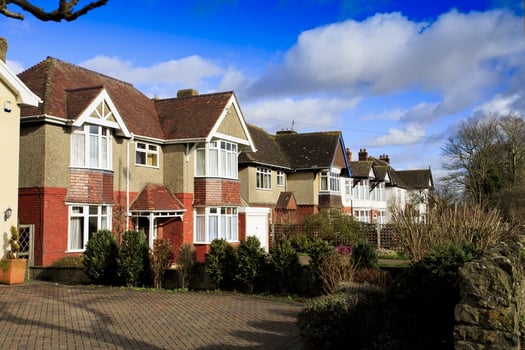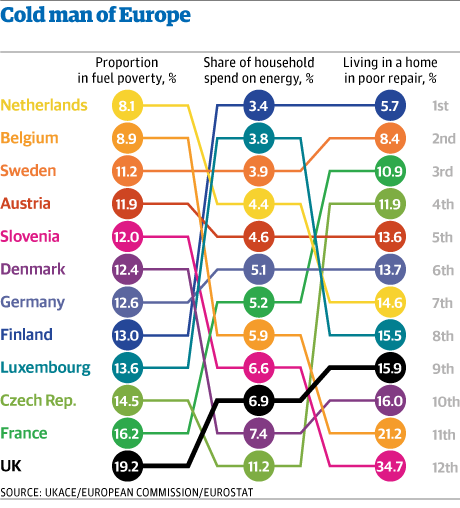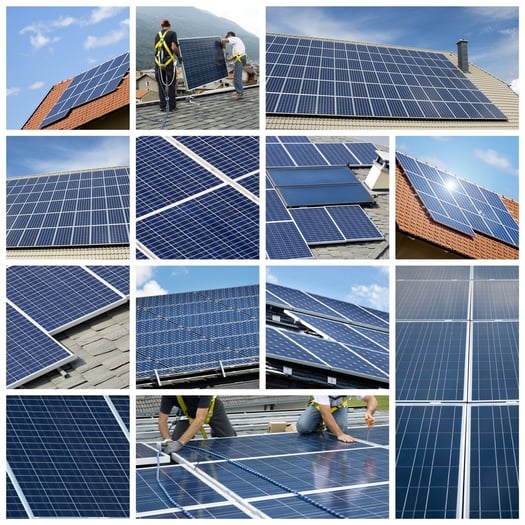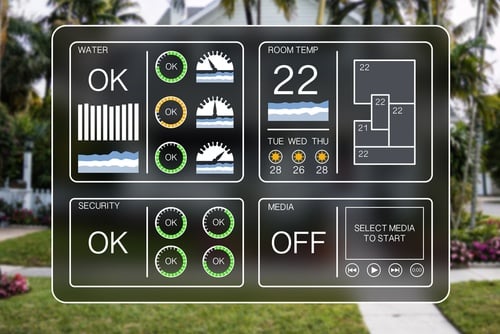How many of us wake up on a winter’s morning and crank the thermostat up because we feel a little chilly?
The majority of us that live in the UK will reside in a home built before the 1980’s when there was no requirement for insulation.
It is no surprise that the amount we spend on energy is the highest in Europe with fuel poverty on the increase.
Paul King, the Chief Executive of the UK Green Building Council has commented that "We have some of the oldest and leakiest houses in Western Europe”.
This is evident from the statistics shown below and it is shocking to see that we have some of the lowest standards throughout Europe. The amount we spend on energy is the highest in Europe with fuel poverty on the increase.

We can all make improvements to our existing homes and improve our carbon footprint. But wouldn’t it be great to live in a property that produces no carbon dioxide emissions. Better still, one that even offsets the carbon dioxide emissions of other activities?
A zero carbon house would mean you would have practically no energy bills. A negative carbon house would even make you money!
What is a zero carbon home?
When you think of a zero carbon home your imagination may conjure up images of futuristic homes or maybe the home of Tom and Barbara Good with their home made generator and pigs and goats in the back garden.
A zero carbon home produces its own source of energy, it is a power generator in its own right.
The appearance of a zero carbon home may seem quite conventional from what you can imagine. They can be designed to look the same as any other house or home.
What makes a property zero carbon is simply that the home that can generate its own energy from renewable sources sufficient to sustain energy demands of the dwelling, and even produce enough to deliver surplus power in return for payment.
A zero carbon home should be low maintenance and future-proof for not only you as the home owner, but also environment:
1. It should not contribute towards the climate change problem during its lifespan.
2. You would not suffer from fuel poverty due to a change of personal circumstances.
3. You won’t be affected by rising fuel prices.
4. It will be a healthier building to occupy with no condensation, no drafts, no mould, no cold spots or particularly cold rooms, and the air is fresh from natural or mechanical ventilation.
How can this be achieved?

A zero carbon home does not rely solely upon the conventional supply of gas, electricity and water as does a typical new build home. Instead the building is designed to utilise the materials and energy from its locality to create a sustainable semi-independent working home with improved thermal comfort irrespective of climate.
To meet the current criteria for a zero carbon dwelling design consideration must be given to;
1. Orientation
The orientation of the house is directly related to how much passive solar gain, natural light & heat can be sourced from the sun. Living areas (in the UK) should be on the south side to maximise on solar gain.
2. Think local
What materials will the house be built from and where will the contractors come from?
Try to use natural, recycled or reclaimed materials for every part of the build, for example source materials from sustainable sources in the local economy.
Building materials and contractors located within a short driving distance cuts down on pollution, and helps to build local identity whilst helping the local economy too. It is important to ensure that materials will be responsibility sourced. Your architect or a sustainable builder would be able to assist with sourcing materials.
3. Insulation, insulation, insulation
Insulating the floor, walls and roof to a high degree, referred to as "super insulation" will isolate the internal environment of the house from the external weather and climate.
Insulating the dwelling to a high standard will not only improve the thermal comfort, but also reduce the energy requirements. The aim is to reduce demand to such an extent that all of the building's energy needs can be met through renewable technologies.
4. Thermal Mass
Providing a good thermal mass (using a heat store such as exposed masonry, concrete or rammed earth) will stabilise the ambient temperature within the building keeping the house cool in summer and warm in winter despite rapid changes in temperature outside.
5. Air Tightness
A dwelling designed with increased air tightness will minimise the amount of warm air escaping the building (this is the uncontrolled, 'bad ventilation'). Natural or mechanical ventilation systems will maintain healthy indoor air quality when the windows are closed, and can pre-heat incoming fresh air such as in the case of MVHR systems (Mechanical Ventilation Heat Recovery).
Advanced window technology will help to create an air sealed environment. Gas filled triple glazing will achieve greater heat retention through sun gain and prevent heat loss.
6. Renewable energy
The home can generate its own renewable energy from;
-
wind turbines,
-
solar PV panels,
-
solar water heating,
-
wood fuelled heating,
-
hydroelectricity
-
air and ground source heat pumps can multiply energy input.
Will a zero carbon house cost more to build than an average new build home?

The checklist of renewable energy sources may at first sound like an expensive shopping list of materials to add to your build cost, coupled with cost of using specialist contractors to install the products.
Don’t be alarmed; the additional costs associated with building to a zero carbon standard have significantly declined and better still they are expected to continue to fall as we approach the Government’s 2016 deadline for building all new homes to a zero carbon standard.
The Sweett Group have found that, “At today’s prices, the typical additional cost of building a semi-detached house to the Zero Carbon Standard could be less than £5000.”
Imagine that; the cost of making your own home into a self-generating energy source, where the building materials have a longer life span, ensured thermal comfort all year in a healthier living environment and it may even generate you money from the surplus energy it makes.
Generate enough energy, and you could technically become mortgage free as feed in tariffs cover your repayments.
However, relative to the overall build cost of your project, an additional £5,000 is a small percentage to pay for the long term gain of a comfortable low energy and low running cost home.

